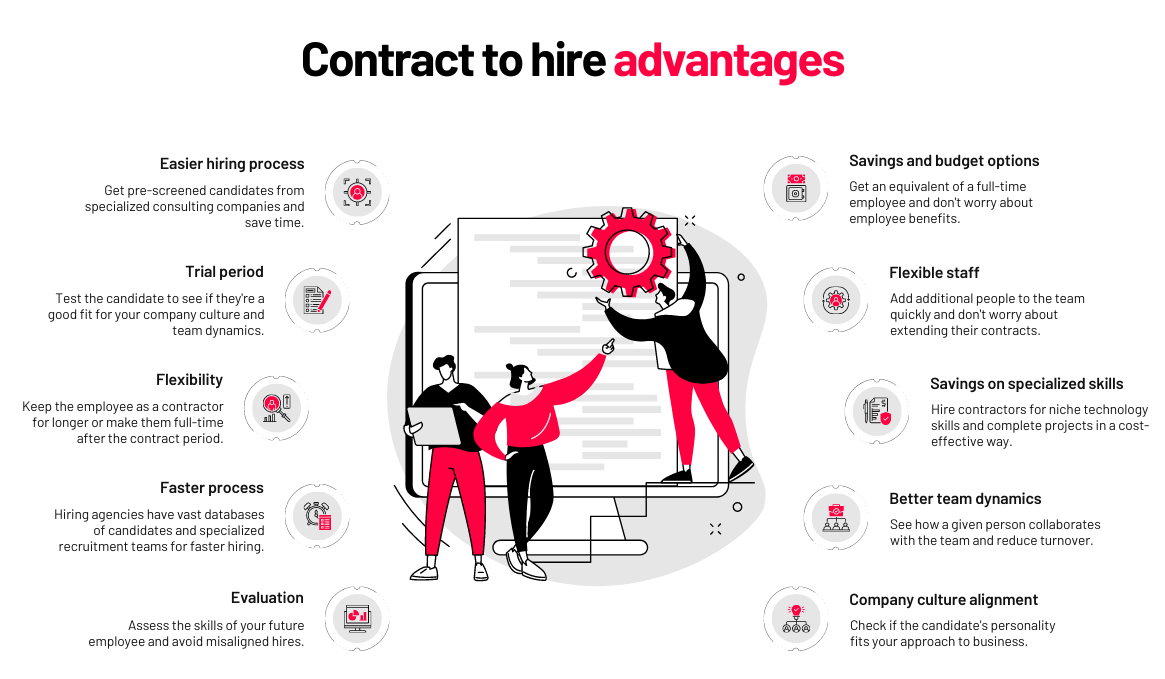Not every business benefits from contract-to-hire roles. While this model offers several advantages, the added expenses aren’t always justified. It’s most effective for organizations hiring high-level or specialized professionals who need to be evaluated before a long-term commitment. However, for lower-cost positions, this approach may not provide enough value. With that in mind, let’s take a closer look at the key benefits of a contract-to-hire strategy.

Your internal recruitment team doesn’t need to handle every step of the hiring process. By partnering with a staffing agency, you can offload the groundwork. Simply share your requirements, budget, and expectations, and the agency will provide you with pre-screened candidates. You’ll only need to manage the final selection and make the hiring decision. Moreover, specialized consulting firms often maintain a ready pool of qualified candidates, helping you fill niche roles faster and significantly shortening the overall recruitment timeline.
For many organizations, this is the biggest advantage of the contract-to-hire model — it allows both the employer and the candidate to evaluate fit before making a long-term commitment. During the contract period, such as a three-month trial, you have the opportunity to assess whether the candidate truly meets your expectations. You can observe how they adapt to the company culture, collaborate with the team, and demonstrate leadership or problem-solving abilities. Meanwhile, the candidate also gains insight into whether the company aligns with their career goals and values, making it a mutually beneficial “trial period.”
When hiring full-time employees, making changes to the employment contract can be challenging, and candidates often hold greater negotiating power. In contrast, a contract-to-hire arrangement allows you to evaluate an employee’s performance before making a long-term commitment. If, after the trial period, an agreement isn’t reached or budget limitations arise, it’s often easier to extend the contract rather than immediately seek a replacement. Adopting a contract-to-hire approach also means setting clear expectations and following a distinct set of guidelines right from the beginning.
Hiring agencies maintain extensive databases of candidates, including those with highly specialized skills. They also have insights into who is actively seeking new opportunities and who isn’t currently looking to change roles. In addition, these agencies employ dedicated recruitment teams that focus on specific job categories. For instance, one of Maxima’s recruiters specializes in executive-level placements and is trained to identify qualities unique to leadership positions. This specialized expertise allows the hiring process to move more efficiently, ensuring candidates are closely aligned with your requirements and helping you make the right hire faster.
As an employer, a contract-to-hire arrangement gives you more time to evaluate a potential employee’s skills and performance. If the initial weeks don’t confirm they’re the right fit, you can easily extend the contract without additional risk. At the same time, the candidate has the opportunity to determine whether your company and the role align with their career goals. This mutual evaluation helps you attract and retain top talent while minimizing the costs and disruptions caused by a poor hiring match.
When managing a tight workforce budget, contract-to-hire arrangements allow you to access the expertise of a full-time employee while utilizing your CapEx budget. In this model, the agency handles all employee benefits, including healthcare, retirement plans, and other perks, so your company isn’t responsible for them. Additionally, contract-to-hire employees are typically paid only for the hours they work, rather than receiving a fixed monthly salary, making it a more flexible and cost-efficient option.
Contract-to-hire positions help you avoid the risks of overstaffing. You can quickly bring additional team members on board, but if a project concludes earlier than anticipated, you’re not obligated to extend their contracts. In these situations, it becomes the agency’s responsibility to find alternative projects that match the employees’ skills, ensuring flexibility for your team without added burden.
Finding niche technology skills, particularly among senior talent, can be challenging—especially when these skills are only needed for a short-term project. Hiring a full-time employee in such cases can be time-consuming and costly, whereas bringing on a contractor is often faster and more cost-effective. Contractors can help you complete projects efficiently, and if the project expands or you require their expertise long-term, you have the option to transition them into a full-time role.
Hiring engineers can be costly, but bringing in someone who isn’t the right fit can be even more expensive. A contract-to-hire arrangement allows you to evaluate how a candidate collaborates with your team, tackles challenges, and applies their expertise. This approach helps reduce turnover when the interview process alone may not fully reveal a candidate’s capabilities.
Hiring engineers can be costly, but bringing in someone who isn’t the right fit can be even more expensive. A contract-to-hire arrangement allows you to evaluate how a candidate collaborates with your team, tackles challenges, and applies their expertise. This approach helps reduce turnover when the interview process alone may not fully reveal a candidate’s capabilities.
Permanent employees perform best when their values and work style align with your company culture. Typically, new hires aren’t fully exposed to the culture until they start, making it a bit of a gamble. With a contract-to-hire arrangement, however, you have the opportunity to assess whether a candidate’s personality and approach to work are a good fit for your organization before making a long-term commitment.